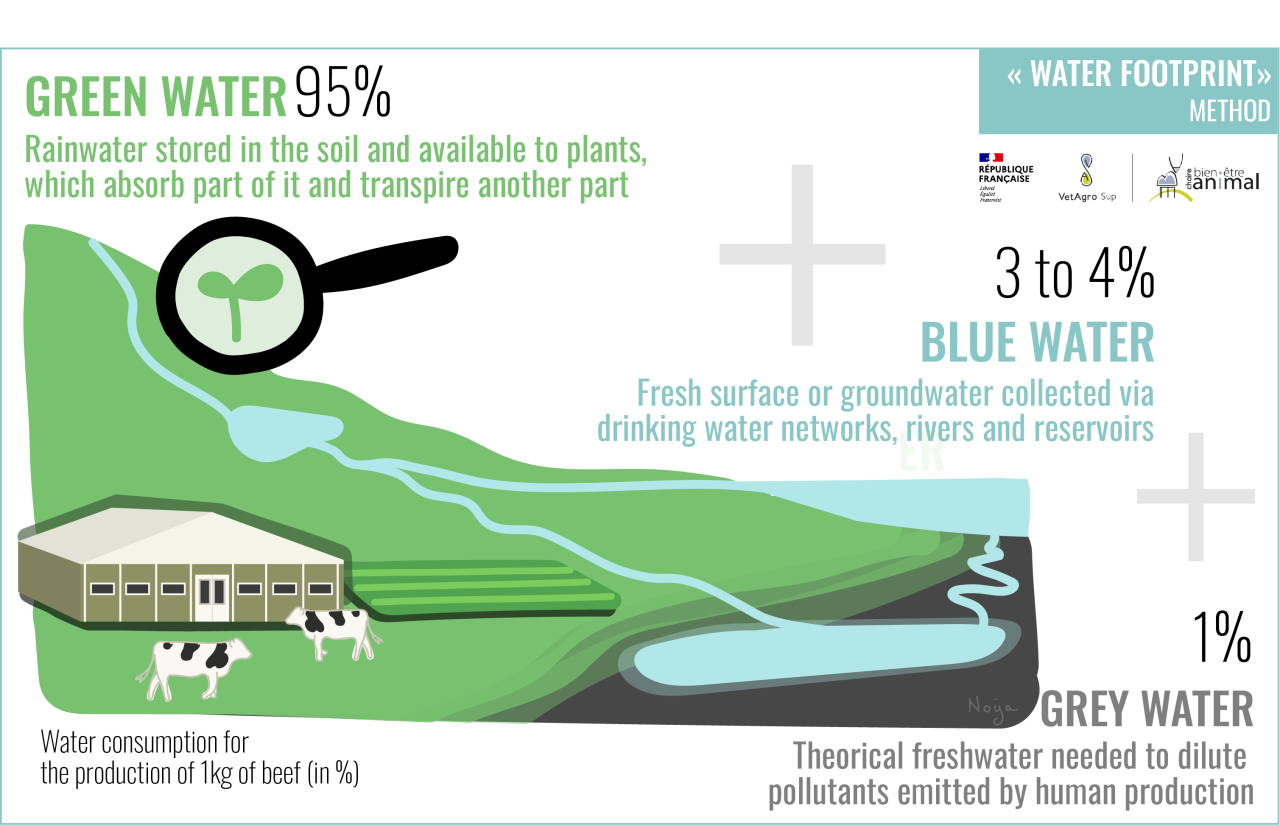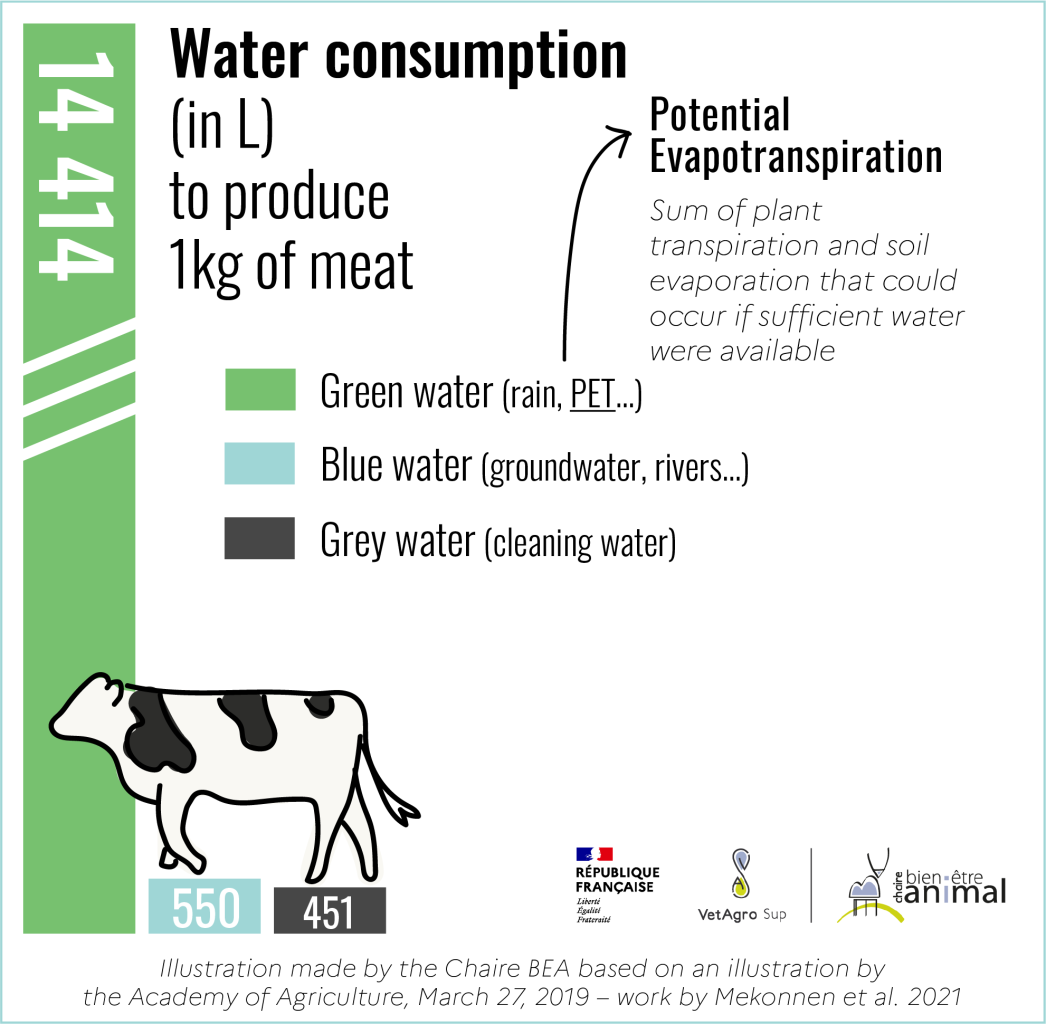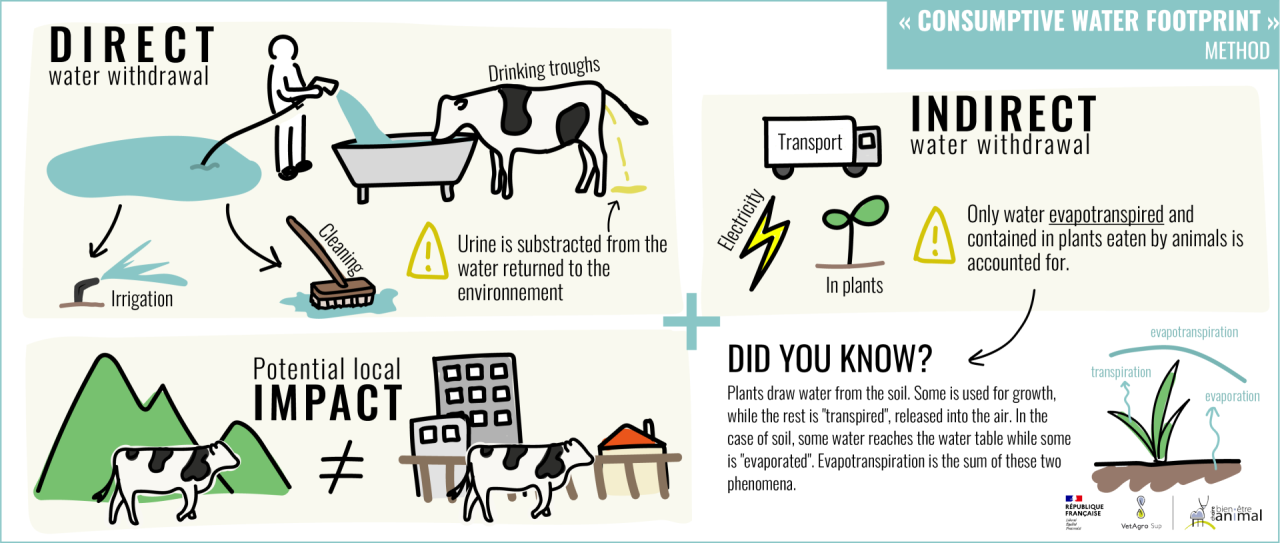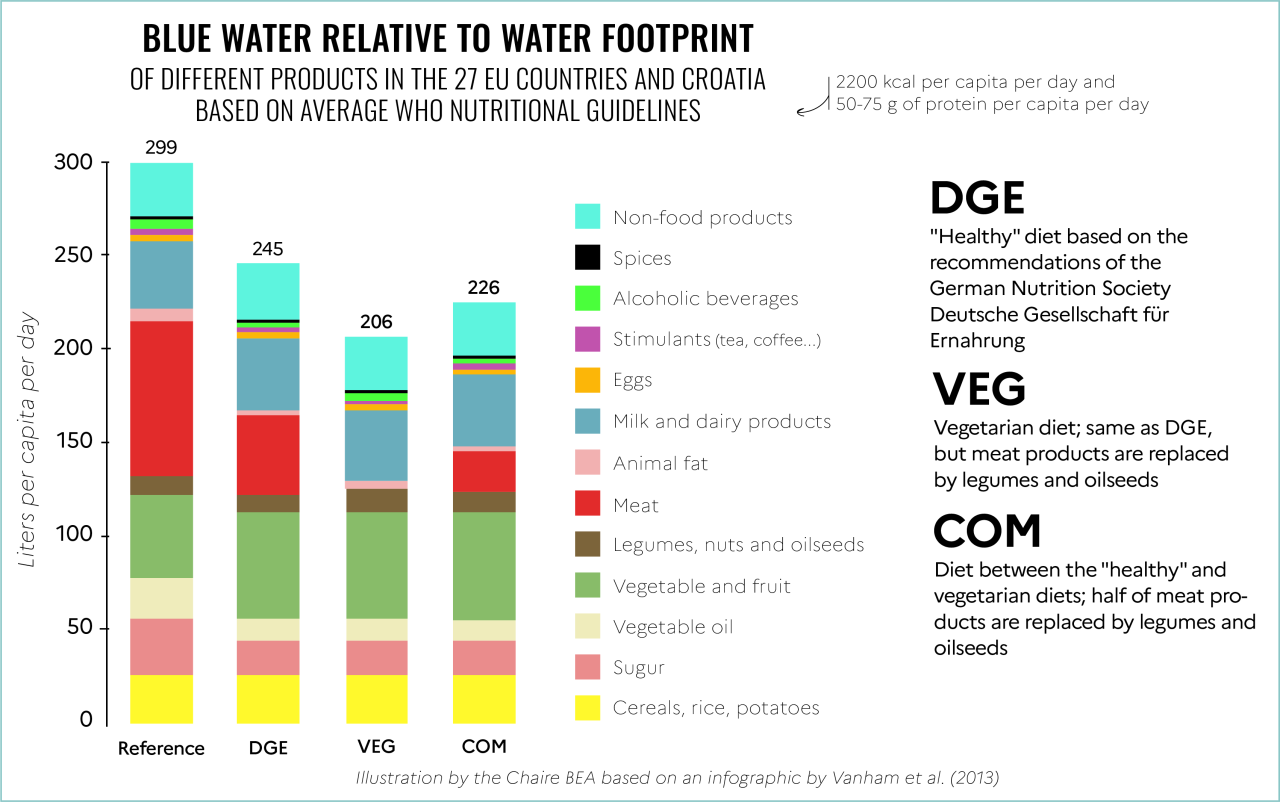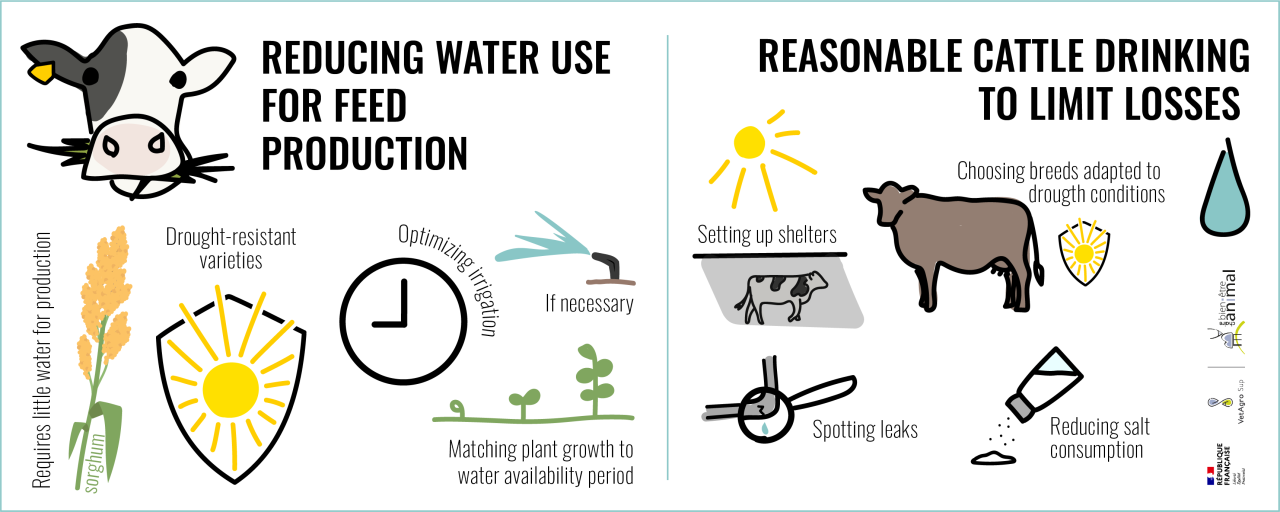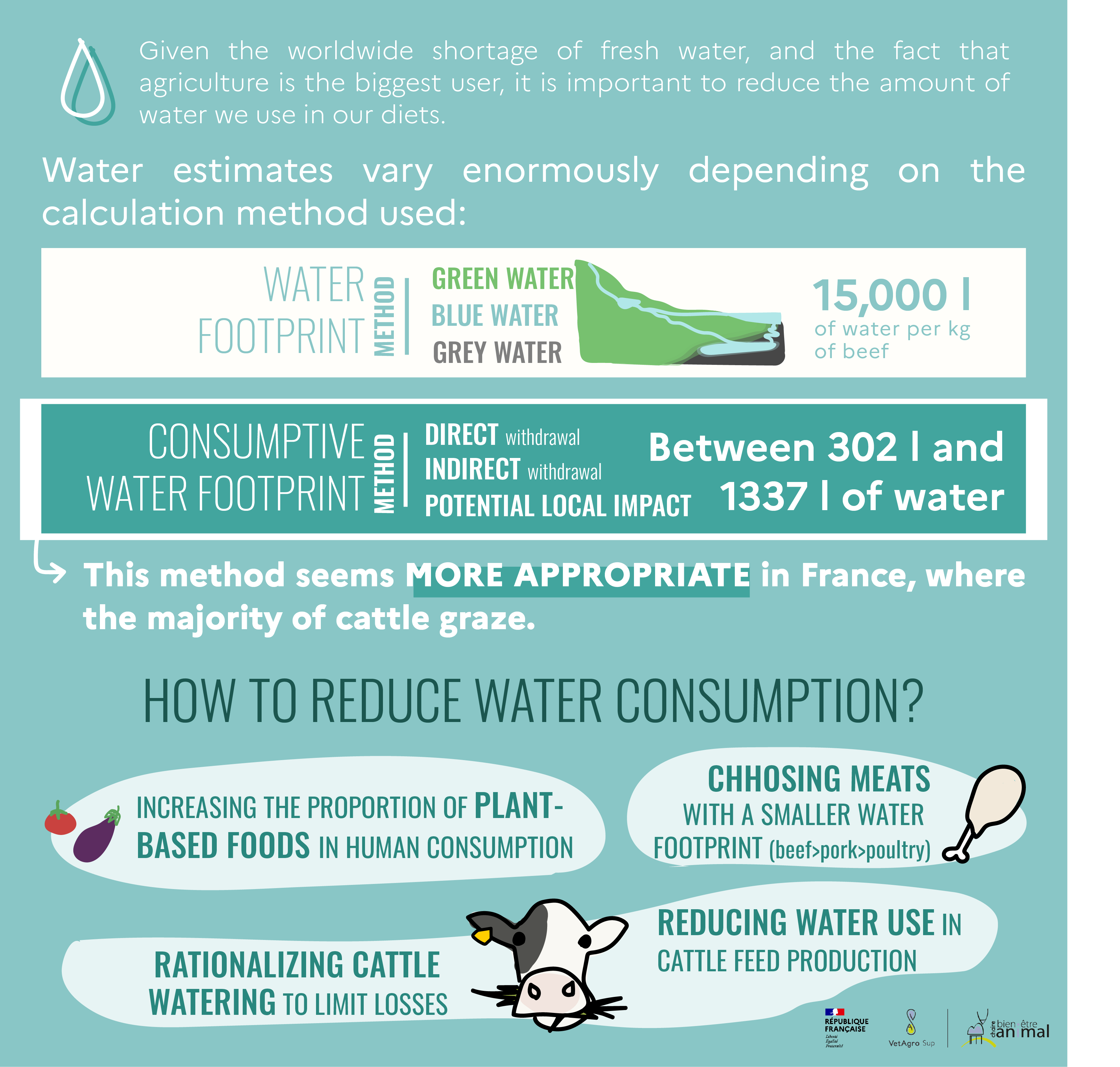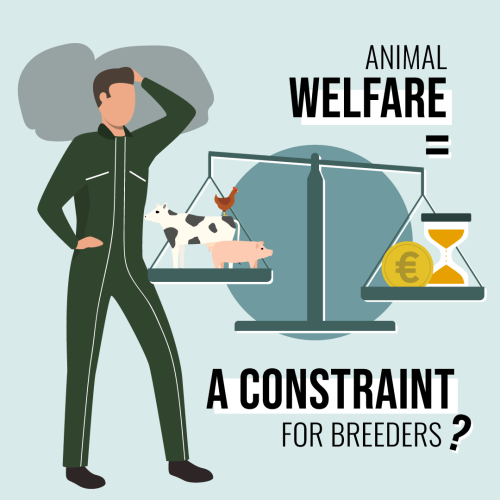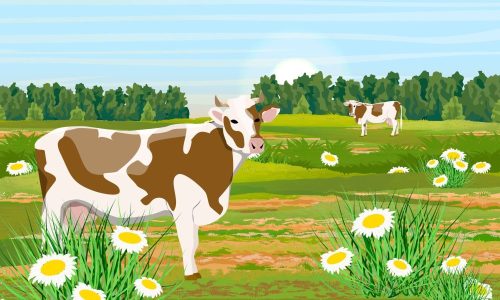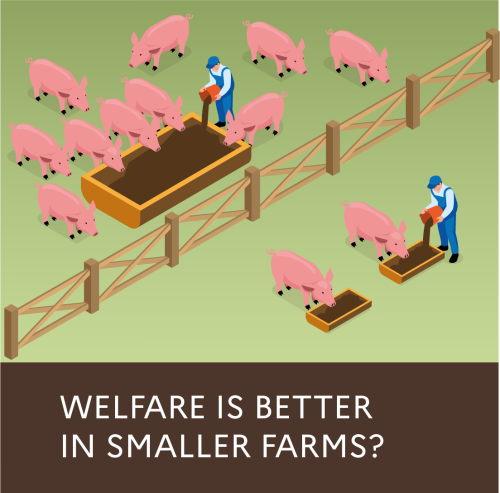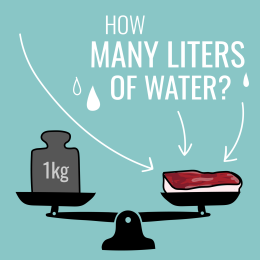

TRUE... AND FALSE!
It all depends on environmental conditions, animal feed and, above all, the water being counted and the method of calculation! So this is not simple... Depending on the calculation method, the figures given can vary from around 20 liters to 15,000 liters of water for 1 kg of beef.
Keep in mind
- In view of the global shortage of freshwater and because agriculture is the biggest consumer, it is important to reduce water use in food production.
- Estimates of water used for producing 1kg of beef vary enormously depending on the calculation method used.
- The "water footprint" method estimates 15,000L of water used per kg of beef, but does not take sufficient account of the natural water cycle.
- The "consumptive water footprint" method estimates between 302 and 1337L of water used per kg of beef. This method seems more relevant in the case of France, where the majority of cattle graze.
- To reduce our water consumption, we can: increase the proportion of plant-based foods (which use less water) in our diets, choose meats with a smaller water footprint, and reduce the direct water consumption of animals and the water used to produce their feed.
Agriculture is the world’s biggest user of freshwater. While this natural resource runs increasingly scarce, it is important to understand freshwater use for livestock activities, as well as the associated calculation methods and levers for action.

Did you know?
According to the Food and Agriculture Organization of the United Nations, agriculture is the world's biggest user of water, accounting for over 70% of global use, and constantly increasing. These withdrawals correspond to water used for irrigation, livestock breeding and aquaculture[1]. It should also be noted that the 6th planetary boundary for the global freshwater cycle was crossed in 2023, jeopardizing the stability of the Earth system.
The water cycle is complex. The term “water footprint” is usually used to estimate the quantity of freshwater required to produce human food. But this generic term covers very different calculation methods. Let’s take a look at the two most commonly cited calculation methods: “water footprint” and “consumptive water footprint“.
Water footprint assessment
When the 15,000 liters of water needed to produce 1 kg of beef figure is put forward, this is generally derived from the “water footprint assessment” calculation method.
This method, developed in 2002 by Arjen Hoekstra and promoted by the Water Footprint Network, was a precursor in the methodological development of water footprint calculations, particularly in the industrial sector. It involves taking a theoretical inventory of the quantity of water required to produce something throughout the manufacturing process, while also taking into account the degradation of water quality associated with production.Some of the water required to manufacture products is often “invisible” to consumers. For example, when we calculate the “water footprint” of a cup of coffee, we take into account the water needed to grow the coffee plant, harvest the berries, process them, package them, transport them… and then to make coffee!

In concrete terms, the “water footprint” method for the production of 1 kg of beef distinguishes and adds up:
- Blue water: this is fresh surface and underground water collected via the drinking water network, rivers and reservoirs and used for livestock farming (watering, crop irrigation, building cleaning) and cattle slaughtering. On average, blue water accounts for 3-4% of the production of 1 kg of beef.

Did you know?
As with humans, cows' water requirements depend on a number of factors: temperature, humidity, the animal’s physiological characteristics (age, weight, etc.), production level (dry cow, dairy or suckler cow, etc.), feed composition, etc. Cow water consumption can thus vary between 10 and 21L of water/day for a young weaned calf, and 65 and 130L of water/day for a dairy cow[2].
In addition to the need for adequate water supply, water quality is also essential for ensuring the animal’s health and welfare.
- Green water: this is rainwater stored in the soil and available to plants, which use part of it for growth and transpire another part. Another fraction is evaporated by the soil. According to this calculation method, all rainwater falling on grassland, crops and fodder eaten by animals is accounted for, which is a point of major debate within the scientific community, as some of the rainwater that falls on plants ends up in groundwater or watercourses and is therefore not used directly for meat production. On average, green water accounts for about 95% of the water used for the production of 1 kg of beef.
- Grey water: this is the theoretical freshwater needed to dilute the pollutants emitted by human production activities, in order to make water available again. . For example, excess nitrogen from effluent or from fertilization and forage production is a water pollutant associated with cattle farming. It should be noted that there are uncertainties and debates within the scientific community concerning the calculation of the quantity of grey water, and that it varies greatly according to the nature of the pollutant and the maximum pollution concentration threshold adopted[3]. On average, gray water represents 1% of the production of 1 kg of beef.
Note that this “water footprint” assessment takes into account all the theoretical water that comes into play during the production chain, and therefore does not exclude the (significant) quantity of green water which returns to the water cycle and is not directly used by animals.
📌 For more information
The water from the “water footprint” is sometimes called “virtual water” because it is not measured directly, but estimated on the basis of known scientific data and model predictions of plant water requirements.
Based on this method, it is now generally accepted that producing 1 kg of beef requires an average of 15,000 liters of water worldwide, 95% of which is green water[4].
However, this figure is not necessarily representative of all livestock farming in France or worldwide, and must therefore be used with caution and contextualized according to geographical location and farming practices. Indeed, according to this method, a very extensive farm with large grazing areas occupied by few cattle will have a greater “water footprint”, due to more green water being counted.
"Consumptive water footprint"
Another calculation method was developed in 2014 to assess the environmental impact of a product (here 1 kg of beef) on the depletion of local water resources: the “consumptive water footprint“, which follows the ISO 14046 standard. The development of this standard required five years’ work and the input of 300 international contributors. This method focuses more on consumed blue water and the impact of its withdrawal at local level.
📌 Please note
The two calculation methods, “water footprint” and “consumptive water footprint“, should not be set against each other: they do not estimate the same thing and do not have the same objective. The former looks at water management as a resource from a global perspective; the latter looks at the specific environmental impact of a product.
The “consumptive water footprint” method for the production of 1 kg of beef distinguishes and adds up:
- The amount of water taken directly from their natural environment by animals: i.e. the water required for watering, irrigating crops, cleaning buildings and equipment, etc., minus the water returned to the environment via effluents. For ruminants, for example, it is generally considered that around 50% of drinking water is returned to the environment in the form of urine[5].
- The quantity of water indirectly used by the animals: i.e. the water required for the growth of plants consumed by the animals, for the production of feed, fertilizers, electricity, etc. It is considered that the the natural environment receives water, part of which feeds the natural vegetation, regardless of the presence of animals. The share of water taken into account in the production of 1 kg of beef therefore concerns only the water that is evapotranspired by or contained in the plants the animals eat, as opposed to all the water that falls on the plots and returns to the water table, rivers and soil. The quantity of water taken into account in this method is therefore necessarily smaller than that taken into account in the “water footprint” method.
- The potential local impact of this water withdrawal: producing 1 kg of beef will not have the same “consumptive water footprint” depending on the geographical and environmental conditions in which the cow is raised. For example, if a cow is reared in a temperate natural environment where human water withdrawals are low, such as in mountain meadows, the potential local impact of water withdrawal will be lower than if it is reared in a drier natural environment with a high concentration of human water needs (densely populated areas, industrial basins, etc.). The potential local impact is calculated using a weighting factor (see box below) designed to take into account water scarcity in a given environment. .
The weighting factor used to measure the potential local impact of water use is also known as “Water Stress Index“. In France, depending on the region and the methodology, the Water Stress Index varies between 0.073 and 0.320 (Pfister and Bayer, 2014)[6] or between 1.05 and 14.34. (Boulay et al, 2018)[7]. It should be noted that the European Union and the United Nations recommend the use of the Boulay et al. Water Stress Index, more used than the one of Pfister and Bayer. In 2014, the Institut de l’Elevage (Idele) conducted a study[8] estimating the “consumptive water footprint” of beef, using the “Water Stress Index” by Pfister and Bayer (2014). According to this study, the “consumptive water footprint” of 1 kg of beef produced in France varied between 20 and 50 liters. By contrast, if we apply the “Water Stress Index” of Boulay et al. (2018), the “consumptive water footprint” of 1 kg of beef produced in France varies between 302 and 1337 liters[9].
According to the “consumptive water footprint” method, 302 to 1,337 liters are required to produce 1 kg of beef in France. These figures appear much lower than those estimated by the “water footprint” method, because the “consumptive water footprint” method focuses mainly on blue water, taking into account the water returned to the natural environment via effluents. In this sense, it seems more relevant if we try to take into account the natural water cycle and the breeding conditions under which cattle are raised in France, where most of them graze. However, it does not take into account grey water, which may be negligible from a quantitative point of view, but allows us to factor in the pollution associated with the production of 1 kg of beef. According to the Idele study[10]the biggest contributor to French beef farms’ “consumptive water footprint” is the water needed for the production of purchased feed (between 31% and 87%), exceeding by far water consumption by the animals themselves. Electricity, fuel and fertilizers account for a small share.
The water required to produce animal feed can vary according to geographical location, farming systems and methods (animal grazing, quantity and type of feed purchased, etc.), but also according to the “water footprint” of the plant production used for animal feed, which is sometimes difficult to estimate.
When most of the feed comes from soybean requiring intense irrigation, as in the USA for example, the water of purchased feed inputs constitutes a significant part of the footprint, increasing the water footprint of 1 kg of beef. This share is significantly reduced in a system where the nitrogen input of the cattle feed does not come from water-consuming soybeans, but from legumes such as faba beans, which do not require irrigation.
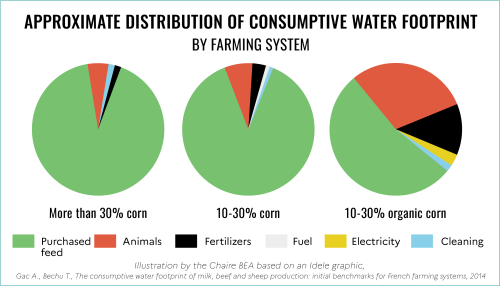
This figure, based on the Idele study, shows, for example, that purchased feed accounts for 55% to 95% of the water footprint of the cattle studied, some of which are partly fed with corn, that is particularly water-hungry during the summer months. We can see that the greater the percentage of corn in cattle feed, the greater the water footprint associated with feeding. We can also see that the percentage of the water footprint related to feed purchases is significantly reduced in the 10-30% Organic Farming corn system. These data are strongly influenced by the nature of the feed purchased and the related irrigation systems.
However, the “consumptive water footprint” varies more with the local context (where the farm is located) than with the farming system and method (grass-fed, soybean feed, etc.). This is what the Idele study showed by comparing different breeding systems in the same given context on the one hand, and identical breeding systems in very different contexts such as France and New Zealand on the other.
Reducing water use in food production
Freshwater availability is becoming increasingly scarce as a result of climate change. Since agriculture is responsible for 70% of global freshwater use, limiting water consumption for livestock farming appears to be a lever. In this respect, increasing the proportion of plant-based foods in human consumption can reduce water use, as their production generally requires less water per kg than meat-based foods[11][12]. On the basis of a similar protein intake, vegetarian diets thus have a smaller water footprint[13].
We also know that beef production’s water footprint is generally greater than pork, which in turn is greater than poultry[14]. It is therefore possible to reduce the water footprint of a meat diet by choosing the type of meat consumed (while taking into account the animal welfare standards applied on the farm in question)..
Having said that, is it possible to reduce water use in beef production?
Considering the weight of the various items in the water footprint of 1 kg of beef, the main levers for reducing water use are: reducing the water used to produce cattle feed, and reducing direct and indirect water consumption by the animals[15].
In concrete terms, the following measures can be listed:
- Reducing the use of water in cattle feed: give preference to feeds that require little water for production (e.g. faba beans or sorghum), use varieties that are more resistant to drought, improve farming practices to match the plant growth period with the period of water availability, optimize irrigation when necessary (time of day, duration, method used).
- Reasonable cattle drinking trough use to limit losses: For example, provide cattle with shelter (buildings, trees, hedges, etc.) to reduce their exposure to heat and limit water loss through transpiration, select breeds adapted to drought conditions, reduce the consumption of salt-rich feed, install water meters to identify leaks and assess avenues for improvement.
Other levers for action can also be mentioned, although they account for a much more negligible share of water consumption, such as giving priority to water-saving methods for cleaning equipment (scraping dung from the floor of buildings before washing, using washing equipment with reduced water flow, recycling cleaning water, etc.) or collecting rainwater from roofs, particularly for cleaning buildings.
Conclusion
The two main calculation methods, “water footprint” and “consumptive water footprint“, show wide variations in estimates of the water used to produce 1 kg of beef, ranging from 20 liters to 15,000 liters. The “water footprint” method is interesting because it lists all the theoretical water involved in the production of 1 kg of beef, but is not necessarily relevant to farming contexts where animals have access to pasture, as it does not take into account the natural water cycle. As such, this method is better suited to indoor production. On the other hand, the “consumptive water footprint” method seems more appropriate for farms where the animals graze in part or in full, as is the case for most cattle in France. According to this method, the “consumptive water footprint” of 1 kg of beef produced in France varies between 302 and 1337 liters.
In any case, in a context where freshwater resources are becoming increasingly scarce, and where agriculture is the world’s biggest water user, estimating (and reducing) the water needed for this purpose is an important issue. Increasing the proportion of plant-based foods in human consumption is one way of doing this. For meat products, choosing meats that consume less water is another. In addition, reducing water consumption by animals, and especially that associated with their feed, is another way of moving towards more water-efficient farming systems.
In short
Article reviewed by Michael Corson, research fellow in environmental analysis of livestock production systems at INRAE’s UMR SAS.
[1] FAO, La situation mondiale de l’alimentation et de l’agriculture 2020. Relever le défi de l’eau dans l’agriculture, Rome, 2020, https://www.fao.org/documents/card/fr/c/CB1447FR.
[2] Boudon A., Khelil-Arfa H., Ménard J., Brunschwig P., Faverdin P., Les besoins en eau d’abreuvement des bovins laitiers : déterminismes physiologiques et quantification. INRA Productions Animales, 26 (3), 249-262, 2013, https://hal.science/hal-01210449.
[3] Corson M.S., Doreau M., Évaluation de l’utilisation de l’eau en élevage. INRA Productions Animales, 26 (3), 239-248, 2013, https://hal.science/hal-01209147.
[4]Mekonnen M.M. et Hoekstra A.Y., A Global Assessment of the Water Footprint of Farm Animal Products. Ecosystems, 15, 2012, http://dx.doi.org/10.1007/s10021-011-9517-8.
[5]Corson et Doreau, 2013
[6] Pfister, S., Bayer, P., Monthly water stress: spatially and temporally explicit consumptive water footprint of global crop production, Journal of Cleaner Production, 73, 52-62, 2014, https://doi.org/10.1016/j.jclepro.2013.11.031.
[7] Boulay A., Bare J., Benini L., Berger M., Lathuillière M., Manzardo A., Margni M., Núñez M., Pastor A., Ridoutt B., Oki T., Pfister S., The WULCA consensus characterization model for water scarcity footprints: assessing impacts of water consumption based on available water remaining (AWARE), International Journal of Life Cycle Assessment, 2018, https://dx.doi.org/10.1007/s11367-017-1333-8.
[8]Gac A., Bechu T., L’empreinte eau consommative du lait et de la viande bovine et ovine : premiers repères sur des systèmes français, Colloque Rencontres autour des Recherches sur les Ruminants, 2014, https://idele.fr/fileadmin/medias/Documents/GacBechu2014_3R.pdf.
[9] Fossey, M., L’empreinte eau des élevages herbivores : des flux d’eau prélevés à l’impact environnemental de la consommation d’eau, SNGTV, Bulletin n° 109, 23-27, 2023.
[10] Gac et Béchu, 2014.
[11] Mekonnen et Hoekstra, 2012.
[12] Hocquette JF., Mollier P., Darmon N., Peyraud JL., Faut-il réduire notre consommation de viande ?, La revue française de la recherche en viandes et produits carnés, 2019, 35 (2-4), 1-7, https://hal.inrae.fr/hal-02624148.
[13] Vanham D., Mekonnen M.M., Hoekstra A.Y., The water footprint of the EU for different diets, Ecological Indicators, 32, 1-8, 2013, https://doi.org/10.1016/j.ecolind.2013.02.020.
[14] Gerbens-Leene P.W., Mekonnen M.M., Hoeskstra A.Y., The water footprint of poultry, pork and beef : a comparative study in different countries and production systems, Water Resources and Industry, 1-2, 25-36, 2013, https://doi.org/10.1016/j.wri.2013.03.001.
[15] Corson et Doreau, 2013.
Keep in mind
- In view of the global shortage of freshwater and because agriculture is the biggest consumer, it is important to reduce water use in food production.
- Estimates of water used for producing 1kg of beef vary enormously depending on the calculation method used.
- The "water footprint" method estimates 15,000L of water used per kg of beef, but does not take sufficient account of the natural water cycle.
- The "consumptive water footprint" method estimates between 302 and 1337L of water used per kg of beef. This method seems more relevant in the case of France, where the majority of cattle graze.
- To reduce our water consumption, we can: increase the proportion of plant-based foods (which use less water) in our diets, choose meats with a smaller water footprint, and reduce the direct water consumption of animals and the water used to produce their feed.
Key Figure
agriculture is responsible for 70% of global freshwater use

